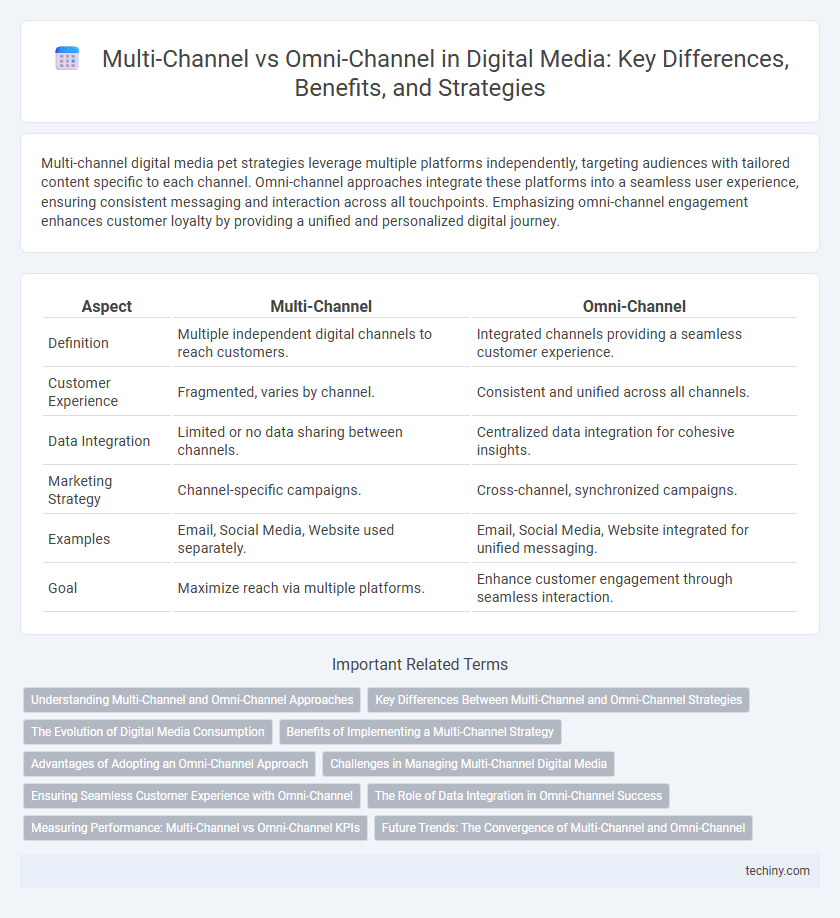Multi-channel digital media pet strategies leverage multiple platforms independently, targeting audiences with tailored content specific to each channel. Omni-channel approaches integrate these platforms into a seamless user experience, ensuring consistent messaging and interaction across all touchpoints. Emphasizing omni-channel engagement enhances customer loyalty by providing a unified and personalized digital journey.
Table of Comparison
| Aspect | Multi-Channel | Omni-Channel |
|---|---|---|
| Definition | Multiple independent digital channels to reach customers. | Integrated channels providing a seamless customer experience. |
| Customer Experience | Fragmented, varies by channel. | Consistent and unified across all channels. |
| Data Integration | Limited or no data sharing between channels. | Centralized data integration for cohesive insights. |
| Marketing Strategy | Channel-specific campaigns. | Cross-channel, synchronized campaigns. |
| Examples | Email, Social Media, Website used separately. | Email, Social Media, Website integrated for unified messaging. |
| Goal | Maximize reach via multiple platforms. | Enhance customer engagement through seamless interaction. |
Understanding Multi-Channel and Omni-Channel Approaches
Multi-channel marketing leverages multiple independent platforms such as social media, email, and websites to reach customers, emphasizing platform-specific strategies. Omni-channel marketing integrates these channels into a cohesive customer experience, ensuring seamless interaction and consistent messaging across all touchpoints. Understanding the distinction is crucial for businesses aiming to enhance customer engagement and optimize conversion rates.
Key Differences Between Multi-Channel and Omni-Channel Strategies
Multi-channel strategies engage customers through multiple independent platforms like social media, email, and websites, each operating in silos with limited interaction. Omni-channel strategies integrate these channels, creating a seamless, unified customer experience regardless of touchpoint. The key difference lies in omni-channel's ability to provide consistent messaging and personalized engagement across all channels, enhancing customer loyalty and conversion rates.
The Evolution of Digital Media Consumption
Multi-channel digital media strategies deliver content through various platforms like social media, websites, and email, allowing users to access information independently on each channel. Omni-channel approaches create a seamless and integrated media consumption experience, ensuring consistent messaging and personalized interactions across all digital touchpoints. This evolution reflects growing consumer demand for fluid engagement and unified brand presence in an increasingly connected digital landscape.
Benefits of Implementing a Multi-Channel Strategy
Implementing a multi-channel strategy enhances customer reach by leveraging various independent platforms such as social media, email, websites, and mobile apps. This approach allows businesses to target diverse audience segments effectively, increasing engagement and brand visibility. Multi-channel strategies also enable better data collection from multiple sources, facilitating informed marketing decisions and personalized customer experiences.
Advantages of Adopting an Omni-Channel Approach
An omni-channel approach in digital media unifies customer interactions across all platforms, providing a seamless and consistent user experience that significantly enhances engagement and satisfaction. This strategy enables comprehensive data integration, allowing for precise audience targeting and personalized content delivery, which boosts conversion rates and brand loyalty. By breaking down silos between channels, businesses achieve greater operational efficiency and a holistic view of consumer behavior, driving more informed marketing decisions.
Challenges in Managing Multi-Channel Digital Media
Managing multi-channel digital media involves complex challenges such as inconsistent messaging across platforms, fragmented customer data, and increased resource allocation for monitoring and engagement. Brands struggle to provide a unified user experience because each channel operates in isolation, complicating campaign tracking and performance measurement. These hurdles often lead to inefficiencies and diminished customer satisfaction compared to the streamlined integration seen in omni-channel strategies.
Ensuring Seamless Customer Experience with Omni-Channel
Omni-channel strategies integrate multiple channels, including social media, websites, mobile apps, and in-store interactions, to create a unified and seamless customer experience. This approach enables real-time data synchronization and personalized communication across platforms, enhancing customer engagement and satisfaction. Multi-channel tactics, while diverse, often operate in silos, limiting the seamless transition and consistent messaging that omni-channel solutions guarantee in digital media environments.
The Role of Data Integration in Omni-Channel Success
Data integration enables seamless customer experiences across multiple touchpoints by unifying information from diverse channels such as social media, email, and in-store interactions. Unlike multi-channel approaches, omni-channel strategies rely on centralized data systems that provide real-time insights, enabling personalized marketing and consistent messaging. Effective data integration drives higher customer engagement, improved retention rates, and optimized campaign performance in omni-channel digital media environments.
Measuring Performance: Multi-Channel vs Omni-Channel KPIs
Measuring performance in multi-channel digital media relies on individual channel KPIs such as click-through rates, conversion rates, and engagement metrics specific to each platform. Omni-channel performance measurement integrates these KPIs into a unified framework, emphasizing customer journey consistency, cross-channel attribution, and overall lifetime value. Effective omni-channel strategies leverage real-time data analytics to optimize seamless interaction across channels, driving higher retention and revenue compared to isolated multi-channel efforts.
Future Trends: The Convergence of Multi-Channel and Omni-Channel
Future trends in digital media highlight the convergence of multi-channel and omni-channel strategies, creating a unified customer experience across all touchpoints. Advanced AI and data analytics enable seamless integration of channels, allowing brands to personalize content and interactions in real time. This convergence drives higher engagement, improved customer retention, and a more holistic understanding of consumer behavior.
Multi-channel vs Omni-channel Infographic

 techiny.com
techiny.com